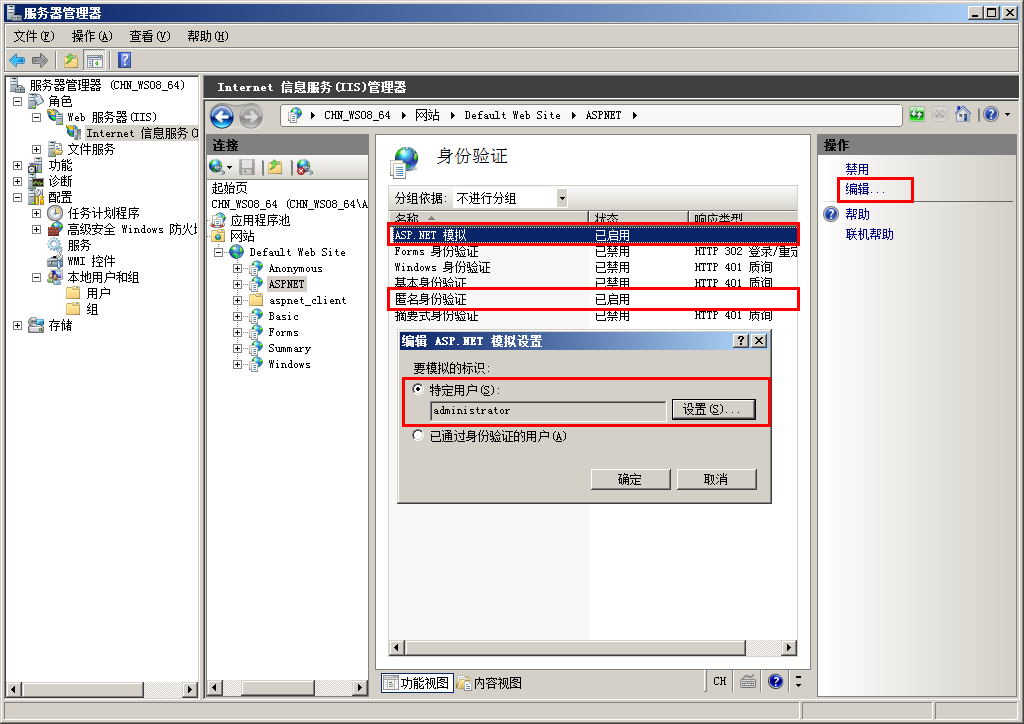ASP.Net模拟用户
springsnow 人气:0一、概述
在实际的项目开发中,我们可能会需要调用一些非托管程序,而有些非托管程序需要有更高的身份权限才能正确执行。本文介绍了如何让IIS承载的ASP.NET网站以特定的账户执行,比如Administrator。
默认情况下禁用 ASP.NET 模拟。如果对某 ASP.NET 应用程序启用了模拟,该应用程序将运行在标识上下文中,其访问标记被 IIS 传递给 ASP.NET。
- 该标记可以是已通过身份验证的用户标记(如已登录的 Windows 用户的标记)【IIS上配置“集成Widows身份验证”且不勾选“匿名访问”的情况下】
- 该标记也可以是 IIS 为匿名用户提供的标记(通常为 IUSR_MACHINENAME 标识)。 【IIS上配置勾选“匿名访问”的情况下】

二、读取被模拟用户的标识
注意:可以使用以下代码来确定线程作为哪个用户执行:
WindowsIdentity.GetCurrent().Name
三、模拟 IIS 验证的帐户或用户
若要在收到 ASP.NET 应用程序中每个页的每个请求时模拟 Microsoft Internet 信息服务 (IIS) 身份验证用户,必须在此应用程序的 Web.config 文件中包含 <identity> 标记,并将 impersonate 属性设置为 true。例如:
<identity impersonate="true" />
四、为 ASP.NET 应用程序的所有请求模拟特定用户
若要为 ASP.NET 应用程序的所有页面上的所有请求模拟特定用户,可以在该应用程序的 Web.config 文件的 <identity> 标记中指定 userName 和 password 属性。例如:
<identity impersonate="true" userName="accountname" password="password" />
五、在代码中模拟身份验证用户
若要仅在运行代码的特定部分时模拟身份验证用户 (User.Identity),您可以使用以下代码。此方法要求身份验证用户标识的类型为 WindowsIdentity。
WindowsImpersonationContext impersonationContext = ((WindowsIdentity)User.Identity).Impersonate(); //Insert your code that runs under the security context of the authenticating user here. impersonationContext.Undo();
六、在代码中模拟特定用户
若要仅在运行代码的特定部分时模拟特定用户,请使用以下代码(使用Windows API):
<%@ Page Language="C#"%>
<%@ Import Namespace = "System.Web" %>
<%@ Import Namespace = "System.Web.Security" %>
<%@ Import Namespace = "System.Security.Principal" %>
<%@ Import Namespace = "System.Runtime.InteropServices" %>
<script runat=server>
public const int LOGON32_LOGON_INTERACTIVE = 2;
public const int LOGON32_PROVIDER_DEFAULT = 0;
WindowsImpersonationContext impersonationContext;
[DllImport("advapi32.dll")]
public static extern int LogonUserA(String lpszUserName,
String lpszDomain,
String lpszPassword,
int dwLogonType,
int dwLogonProvider,
ref IntPtr phToken);
[DllImport("advapi32.dll", CharSet=CharSet.Auto, SetLastError=true)]
public static extern int DuplicateToken(IntPtr hToken,
int impersonationLevel,
ref IntPtr hNewToken);
[DllImport("advapi32.dll", CharSet=CharSet.Auto, SetLastError=true)]
public static extern bool RevertToSelf();
[DllImport("kernel32.dll", CharSet=CharSet.Auto)]
public static extern bool CloseHandle(IntPtr handle);
public void Page_Load(Object s, EventArgs e)
{
if(impersonateValidUser("username", "domain", "password"))
{
//Insert your code that runs under the security context of a specific user here.
undoImpersonation();
}
else
{
//Your impersonation failed. Therefore, include a fail-safe mechanism here.
}
}
private bool impersonateValidUser(String userName, String domain, String password)
{
WindowsIdentity tempWindowsIdentity;
IntPtr token = IntPtr.Zero;
IntPtr tokenDuplicate = IntPtr.Zero;
if(RevertToSelf())
{
if(LogonUserA(userName, domain, password, LOGON32_LOGON_INTERACTIVE,
LOGON32_PROVIDER_DEFAULT, ref token) != 0)
{
if(DuplicateToken(token, 2, ref tokenDuplicate) != 0)
{
tempWindowsIdentity = new WindowsIdentity(tokenDuplicate);
impersonationContext = tempWindowsIdentity.Impersonate();
if (impersonationContext != null)
{
CloseHandle(token);
CloseHandle(tokenDuplicate);
return true;
}
}
}
}
if(token!= IntPtr.Zero)
CloseHandle(token);
if(tokenDuplicate!=IntPtr.Zero)
CloseHandle(tokenDuplicate);
return false;
}
private void undoImpersonation()
{
impersonationContext.Undo();
}到此这篇关于ASP.Net使用System.Security.Principal模拟用户的文章就介绍到这了。希望对大家的学习有所帮助,也希望大家多多支持。
加载全部内容